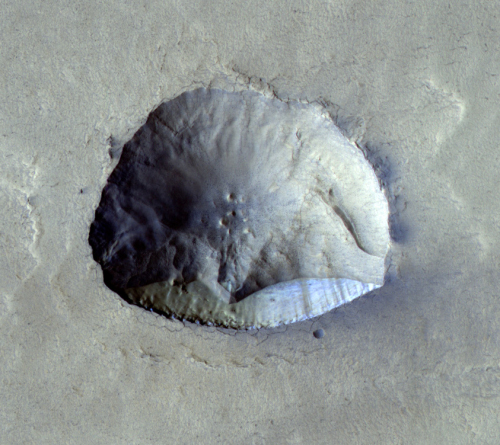Visible clean water ice on Mars
Cool image time! The photo to the right, cropped and reduced to post here, is today’s picture of the day for the high resolution camera on Mars Reconnaissance Orbiter (MRO). Taken on September 13, 2021, it shows an exposed scarp on the southern inner wall of a small 800-foot-wide crater.
What makes that scarp intriguing is its blue color. As noted by Shane Byrne of the Lunar and Planetary Lab University of Arizona, who wrote the caption:
This north-facing cliff appears to expose icy material that’s similar to other pole-facing scarps showing buried ice elsewhere on the planet. These cliffs give us a cut-away view of the buried ice in that location and can help answer questions about what the Martian climate was like when this ice formed.
The crater itself sits inside a much larger crater, as shown in the wider picture below.
The larger crater is about 5-6 miles across and sits at 50 degrees north latitude, smack dab in the middle of the mid-latitude band where many glacial features are found and many craters appear filled with glacial debris. In this case the crater appears almost filled with such debris, so much so that when the small impact occurred — creating the smaller crater with the ice scarp — it created a melted splatter field around that small crater rather than hard ejecta and an upraised rim of rocks, as is typical for most craters.
Furthermore, the smaller crater has apparently become distorted over time, with the different daily temperatures between the south- and north-facing interior rims causing them to erode at different rates.
Scientists using MRO have now found a lot of these ice scarps, generally in the 50 to 60 degree latitude range. While the blue ice in the scarps appears to be very pure water and thus relatively accessible, the high latitudes of these scarps puts them in somewhat inhospitable locations to build colonies. More likely the colonies will be farther south, where the climate will be less harsh, while these scarps themselves will likely be isolated mining operations, shipping the ice south to the colonists.
Then again, it is increasingly possible that ice will be found underground in ample amounts farther south, making mining here unnecessary, at least until the population of Mars grows significantly. The evidence increasingly suggests that as long as a colony is above 30 degrees latitude, especially in the north, ice will be found underground with relative ease.
On Christmas Eve 1968 three Americans became the first humans to visit another world. What they did to celebrate was unexpected and profound, and will be remembered throughout all human history. Genesis: the Story of Apollo 8, Robert Zimmerman's classic history of humanity's first journey to another world, tells that story, and it is now available as both an ebook and an audiobook, both with a foreword by Valerie Anders and a new introduction by Robert Zimmerman.
The print edition can be purchased at Amazon or from any other book seller. If you want an autographed copy the price is $60 for the hardback and $45 for the paperback, plus $8 shipping for each. Go here for purchasing details. The ebook is available everywhere for $5.99 (before discount) at amazon, or direct from my ebook publisher, ebookit. If you buy it from ebookit you don't support the big tech companies and the author gets a bigger cut much sooner.
The audiobook is also available at all these vendors, and is also free with a 30-day trial membership to Audible.
"Not simply about one mission, [Genesis] is also the history of America's quest for the moon... Zimmerman has done a masterful job of tying disparate events together into a solid account of one of America's greatest human triumphs."--San Antonio Express-News
Cool image time! The photo to the right, cropped and reduced to post here, is today’s picture of the day for the high resolution camera on Mars Reconnaissance Orbiter (MRO). Taken on September 13, 2021, it shows an exposed scarp on the southern inner wall of a small 800-foot-wide crater.
What makes that scarp intriguing is its blue color. As noted by Shane Byrne of the Lunar and Planetary Lab University of Arizona, who wrote the caption:
This north-facing cliff appears to expose icy material that’s similar to other pole-facing scarps showing buried ice elsewhere on the planet. These cliffs give us a cut-away view of the buried ice in that location and can help answer questions about what the Martian climate was like when this ice formed.
The crater itself sits inside a much larger crater, as shown in the wider picture below.
The larger crater is about 5-6 miles across and sits at 50 degrees north latitude, smack dab in the middle of the mid-latitude band where many glacial features are found and many craters appear filled with glacial debris. In this case the crater appears almost filled with such debris, so much so that when the small impact occurred — creating the smaller crater with the ice scarp — it created a melted splatter field around that small crater rather than hard ejecta and an upraised rim of rocks, as is typical for most craters.
Furthermore, the smaller crater has apparently become distorted over time, with the different daily temperatures between the south- and north-facing interior rims causing them to erode at different rates.
Scientists using MRO have now found a lot of these ice scarps, generally in the 50 to 60 degree latitude range. While the blue ice in the scarps appears to be very pure water and thus relatively accessible, the high latitudes of these scarps puts them in somewhat inhospitable locations to build colonies. More likely the colonies will be farther south, where the climate will be less harsh, while these scarps themselves will likely be isolated mining operations, shipping the ice south to the colonists.
Then again, it is increasingly possible that ice will be found underground in ample amounts farther south, making mining here unnecessary, at least until the population of Mars grows significantly. The evidence increasingly suggests that as long as a colony is above 30 degrees latitude, especially in the north, ice will be found underground with relative ease.
On Christmas Eve 1968 three Americans became the first humans to visit another world. What they did to celebrate was unexpected and profound, and will be remembered throughout all human history. Genesis: the Story of Apollo 8, Robert Zimmerman's classic history of humanity's first journey to another world, tells that story, and it is now available as both an ebook and an audiobook, both with a foreword by Valerie Anders and a new introduction by Robert Zimmerman.
The print edition can be purchased at Amazon or from any other book seller. If you want an autographed copy the price is $60 for the hardback and $45 for the paperback, plus $8 shipping for each. Go here for purchasing details. The ebook is available everywhere for $5.99 (before discount) at amazon, or direct from my ebook publisher, ebookit. If you buy it from ebookit you don't support the big tech companies and the author gets a bigger cut much sooner.
The audiobook is also available at all these vendors, and is also free with a 30-day trial membership to Audible.
"Not simply about one mission, [Genesis] is also the history of America's quest for the moon... Zimmerman has done a masterful job of tying disparate events together into a solid account of one of America's greatest human triumphs."--San Antonio Express-News




Allllll Right !!!
Fuel and life to BE…..
Everywhere. . . .
“Get yer ice water!” – Elon Musk
Q:
How much perchlorate in this ice?
Since this Post has become today’s fun house!
By All Right I ? MEAN:
https://youtu.be/sl_4I7vLLc4
I know Bob almost never shared ESA space stuff… ( Sorry Bob… But it’s true!)
Here is a wonderful picture and explanation of, water on Mars…
https://www.sciencealert.com/hidden-water-has-been-found-in-the-soil-of-mars-grand-canyon
Occasionally somthing good comes out of our pinko commie Europe!!
Love and lite!
By the way….. I’ve got almost zero comments on my postings on ESA missions…. I hope our space nuts, ( including our host) have a read, look, and think about the science here… Very relevant to the original post. It’s not NASA…. But it’s still wonderful!
Lee Stevenson: The reason I post ESA stuff so rarely is ESA’s only fault. They do not make their images or data easily accessible. I can only wait for their rare press releases, many of which are pure blather and a waste of time (as are many of NASA’s).
If they made the raw images available you can be damn sure you’d see a lot more ESA planetary posts on BTB.